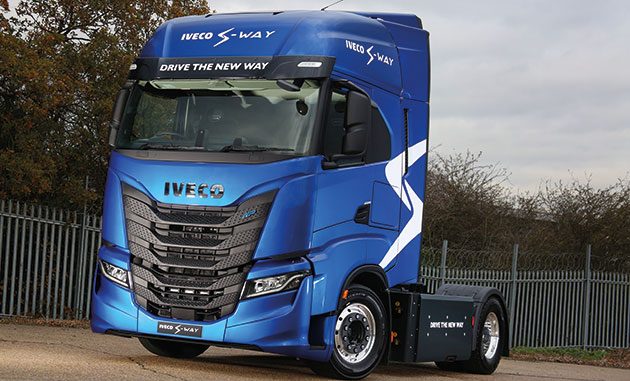
This inaugural Iveco S-Way road test of the right-hand-drive version has been eagerly anticipated, and it also came with the Natural Power CNG driveline.
IT HAS been two years since Iveco launched S-Way in Madrid, with the right-hand-drive (RHD) version introduced last year. When covering the original unveiling (TN September 2019), editor Kevin Swallow welcomed the ‘all-new cab’ as it looked ‘stylish and on a par with its contemporaries in the heavy truck sector’.
He concluded: “It has the potential to make serious inroads into the UK heavy truck market.”
Speaking exclusively to Transport News (TN May 2021) the boss of Iveco Truck and Van UK and Republic of Ireland, Sascha Kaehne, said that more S-Way products are arriving every month and that around one in four arrivals have a gas-powered engine.
Let’s focus on the gas part first. Both compressed natural gas (CNG) and liquified natural gas (LNG) are a viable option. Gas is cheaper than diesel but a gas driveline in a truck is more expensive, so the more mileage you rack up the quicker the return on investment. It’s all about the total cost of ownership (TCO).
GAS FREE
For this particular test, Iveco offered its S-Way NP fitted with a CNG driveline.
Many Scottish operators have invested in LNG trucks. Most were happy with LNG, its range, cost and availability, and large logistic companies like Malcolm Group were planning sizeable renewal programmes incorporating LNG-fuelled trucks.
That went south, literally, when BOC withdrew from the UK market in March, forcing Scottish hauliers to park up gas-fuelled lorries as the nearest available refuelling sites were in Merseyside and Yorkshire.
The CNG situation is no better, but at the same time as BOC were packing up their gas canisters, CNG Fuels announced that it has started building Scotland’s first public access renewable biomethane HGV refuelling station at Eurocentral, off the M8 just outside Glasgow.
That is scheduled to open in November and will be on Townhead Avenue, confirms CNG Fuels CEO Phillip Fjeld. “Compressed biomethane is the only fuel available on-site, also known as Bio-CNG,” he says, and the company is planning two further sites at Larkhall and Livingston to open next year.
So, for this specific test, Mohammad went to the mountain, or in this case, Lymm Truckstop.
Liveried in metallic Boreal Blue, the S-Way 4×2 tractor unit is fitted with the optional Active Space (AS) High Roof sleeper cab. It is powered by the 12.9 litre Cursor 13 CNG fuelled engine boasting 453hp and 2,000Nm torque between 1,100 and 1,600rpm.
The tractor is equipped with four steel CNG tanks totalling 460 litres, which equates to 340 miles (550km). Range is CNG’s Achilles heel.
Iveco’s natural gas engines are characterised by stoichiometric combustion and uses the Otto cycle with spark plugs to ignite the air-fuel mixture injected by a rail, with two injectors per cylinder. The latest version of the Cursor 13 Natural Gas was introduced in 2017.
Fitted with ZF’s 12 speed overdrive transmission branded as Hi-Tronix, with a 3.36 to one rear axle ratio, it also has a hydraulic retarder as standard.
UP FRONT
So, to the cab. It’s worth repeating what is new. The ‘cube’ (or skeleton of the cab) has new side, front, roof and floor sections as well as all new external panels with an emphasis on aerodynamics.
At the back of the cab are longer collars to reduce the open space between the truck and trailer. Around the front of the truck horizontal lines are replaced with angles and curves as well as five airflow slats on the front.
Across the width of the cab is a new one-piece central grille completed with rounded corners and the airflow deflector is relocated down next to the headlamp. These changes, Iveco claimed at the launch, help reduce the drag co-efficiency by 12% and improve fuel economy by up to 4%.
A three piece bumper replaces the one-piece design on Stralis, to reduce costs if one part is damaged, and there is a fold-down step on the bottom section of the grille for the driver to stand on to reach the windscreen.
Longer doors cover two of the three steps into the cab, and the lower part of the door is angled inwards and aligned with the repositioned airflow deflectors.
Gone are the two windowpanes in the side doors replaced by a single piece of glass, improving visibility.
Optional extras fitted to the exterior of the AS High Roof sleeper cab includes ‘bending’ front fog lights, LED headlamps, sun visor and under cab storage.
Kerbweight is like-for-like with the outgoing Stralis equivalent.
ONCE ABOARD
What about inside? Spacious and airy about sums it up. It’s two-tone grey with a darker shade on the floor and engine tunnel contrasted with a lighter, softer shade on the sidewalls and ceiling.
Its three steps to the cab floor, which is approximately 1,400mm from the ground. The cab floor is raised 110mm compared to Stralis, which reduces the engine tunnel height to 95mm. Standing room on the engine tunnel is 2,150mm, 80mm more than Stralis.
By putting in a sunken middle locker of three fitted above the windscreen it makes the central area look and feel very roomy.
On the engine tunnel there is 500mm between the bunk and central console of the dashboard and 785mm between the edge of the upper bunk when lowered and the front of the cab.
Sun visors are manual with the old mechanical version jettisoned after issues with the motor, and there is a pull-out section on the side of the driver’s sun visor to block the sun that invariably shines through the gap next to the pillar.
The Leather Hi-Comfort seat is an option and is very comfortable. Its position is set back 50mm so the driver has more space around the steering wheel. A smart key fob and stop/start button is now on the dashboard next to the automated transmission.
Cruise, phone and media/info controls are on the steering wheel and any remaining switches are housed on the dashboard adjacent to the driver. It’s well laid out. The smart key fob and stop/start button is now on the left of the steering wheel on the dashboard next to the three button automated transmission; Drive, Neutral and Reverse.
For 40 winks there is a one-piece 140mm thick lower bunk that can also be raised to become a lounger. It is very relaxing but bunk comfort is very much a driver’s point of view.
When it comes to cabs, ‘USB points’ is the new ‘cup holder’ in terms of convenience for the driver. Often a driver will have to buy a USB device that slots in the cigarette lighter or one that houses multiple USB slots.
There are eight USBs including four on the sidewalls for the bunks, two on the dashboard and two individual ones located either side of the central console. There are four cup holders.
It is fitted with two fridges and when you stop for a rest up it has a Parking Cooler.
SHORT HAUL
The appraisal of the driveline was a little truncated and involved a trip from Lymm Truckstop west along the M56 to Ellesmere Port, and back again.
With a shorter final drive and overdrive gearbox, the truck happily swings along a tad below 1,200rpm. It didn’t drop a gear with the undulating slopes, although adaptive cruise control was deployed and occasionally the truck decelerated as it approached slower traffic.
It’s smooth through the corners with no hint of oversteer and there is a little bit of cab roll but that could be down to the fact it’s a 4×2 – a rare beast these days.
The best compliment to pay a gas wagon is that it is no different to driving a diesel fuelled truck. Full judgement though will have to wait, as this particular route didn’t put any undue pressure on the driveline.
For a better idea on fuel economy and the TCO and whether it’s viable for Scottish operators, we’ll need to revisit this driveline when the CNG Fuels site at Eurocentral opens up in November.
parked up
Both the exterior of the cab and the inside are excellent. It looks modern on the road, and brought favourable – if somewhat brief and littered with Anglo-Saxon adjectives – reviews from truck drivers at Lymm.
For the driver, the cab is a well thought out place to work and rest in; it utilises space very well, like the two fridges under the bunk and the standing space is more than enough for anyone up to 7ft but less so for any lateral movement.
It’s taken a while for Transport News to get its hands on the S-Way but it’s been worth the wait; it is a truck that is truly the sum of its parts.




